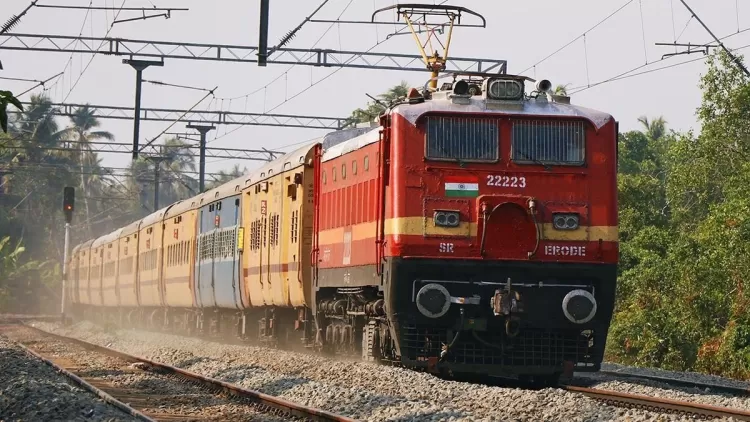India's Railway Capex: A Mixed Reaction to Budget Allocations and Future Prospects
India's railway sector has been a focal point in the recent budget discussions, with mixed reactions regarding the government’s capex (capital expenditure) allocation for railways. While the overall capex has increased by 30%, concerns remain about whether it meets expectations. Vive Loya, Managing Director of Jupiter Wagons, provides insights into the railway capex and its implications for the sector, including the potential boost to freight revenues and the government's push toward green initiatives and EVs.

In the lead-up to India's annual budget, the railway sector was closely scrutinized, with stakeholders hoping for robust allocations to ensure the continued development of infrastructure and rolling stock. The government, however, has faced criticism from some quarters for not meeting the high expectations set by the market.
Vive Loya, Managing Director of Jupiter Wagons, shared his perspective on the budget’s impact, particularly on capital expenditure (capex) for the railway sector. While he acknowledged the government's steadfast focus on rail infrastructure and freight revenue growth, there are underlying concerns about the pace of infrastructure development and its effect on the broader industry.
Railway Capex: A 30% Increase, But Is It Enough?
The government’s allocation for railway capex has increased by around 30% in the latest budget, with a focus on enhancing track infrastructure. This increase is seen as a positive step for the sector, considering the rapid growth in freight demand. The government aims to boost freight revenue, which directly impacts the demand for rolling stock—trains, wagons, and other transport vehicles used for goods transportation.
Loya emphasized that the increased focus on freight corridors and decongesting existing infrastructure would benefit the sector in the long term. However, the actual figures in the budget fell short of market expectations, particularly when considering the larger capex demands required to modernize and expand the country’s railway network. Despite this, Loya believes that the fiscal prudence and consolidation reflected in the budget could pave the way for future policy changes, including rate cuts by the Reserve Bank of India (RBI) that could benefit the broader economy and boost private-sector spending.
A Delayed Yet Positive Outlook for the Railway Sector
While the initial reactions from the market suggest concerns about the government’s railway allocations, Loya remains optimistic about the sector’s future prospects. He pointed out that, outside the budget, the railway sector had seen substantial announcements over the last six months regarding freight corridors and the modernization of passenger rolling stock. These initiatives are expected to alleviate congestion, enhance efficiency, and ultimately benefit logistics and the broader economy.
Loya’s confidence is rooted in the continued demand for rolling stock, driven by the increase in freight revenue. As the infrastructure continues to grow, the need for more transport vehicles will directly impact companies like Jupiter Wagons, which specializes in manufacturing rolling stock.
EV and Green Initiatives: A Parallel Growth Opportunity
Beyond the railway sector, Loya also highlighted Jupiter Wagons’ growing focus on the electric vehicle (EV) space, particularly in the battery and electric truck segments. With the government’s push to reduce the cost of lithium-ion batteries, Loya sees significant potential for EVs to become more competitive with internal combustion engine (ICE) vehicles.
The government’s efforts to lower lithium-ion battery costs are a critical enabler for the EV industry, and Loya believes that this could lead to a stronger push for EV adoption in India. The focus on green initiatives, such as electric trucks and railways, aligns well with the broader goals of sustainability and reducing carbon emissions. This transition to green technologies is expected to give a significant boost to the logistics and transport sectors, further complementing the growth in rail freight.
The Street’s Initial Reaction: Mixed Feelings on Railway Allocations
Despite the optimism from Loya regarding long-term prospects, the initial reaction from the market has been mixed. Following the budget announcement, several companies in the railway and logistics space, including RVNL (Rail Vikas Nigam Limited), IRFC (Indian Railway Finance Corporation), and Jupiter Wagons, saw their stocks drop. These declines are reflective of the street's concerns that the railway allocations did not meet expectations, leading to a sense of caution among investors.
The Bigger Picture: Fiscal Prudence and Market Expectations
The government’s decision to adopt fiscal prudence is seen as a necessary step, especially in light of global economic challenges and the potential reduction in interest rates in major economies like the United States. Lower interest rates in India, facilitated by fiscal consolidation, could eventually lead to increased capex spending by the private sector, including investments in railway infrastructure.
The railway sector, as Loya noted, is poised to benefit from continued infrastructure development. However, for the sector to see significant growth, it requires a combination of strategic policy decisions, private-sector investments, and government support. The government’s emphasis on fiscal prudence in the short term, while focusing on reducing the cost of capital, may offer a more favorable environment for the sector to flourish in the long run.
Conclusion: A Waiting Game for Railway Capex
While India’s railway capex has seen a notable increase in the latest budget, the market's mixed reactions suggest that the allocations have not fully met industry expectations. Nevertheless, the railway sector remains on a positive growth trajectory, driven by infrastructure investments, growing freight revenues, and the government's push toward green and sustainable transport technologies.
The coming months will be crucial in determining whether the government's fiscal strategies will unlock more private-sector investment and whether the railway sector can meet the challenges ahead. For now, stakeholders will be watching closely to see how the market responds to the government's policies and whether the momentum in rail infrastructure can be sustained.
With the growing emphasis on EVs, green initiatives, and decongesting rail networks, India’s railway and logistics sectors are poised for transformation. Whether the budget’s capex allocations are enough to drive this change remains a point of contention, but the potential for growth in the long run remains strong.
What's Your Reaction?

















